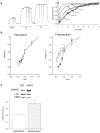Differential contribution of cardiac sarcomeric proteins in the myofibrillar force response to stretch
- PMID: 18449562
- PMCID: PMC2904467
- DOI: 10.1007/s00424-008-0501-x
Differential contribution of cardiac sarcomeric proteins in the myofibrillar force response to stretch
Abstract
The present study examined the contribution of myofilament contractile proteins to regional function in guinea pig myocardium. We investigated the effect of stretch on myofilament contractile proteins, Ca(2+) sensitivity, and cross-bridge cycling kinetics (K (tr)) of force in single skinned cardiomyocytes isolated from the sub-endocardial (ENDO) or sub-epicardial (EPI) layer. As observed in other species, ENDO cells were stiffer, and Ca(2+) sensitivity of force at long sarcomere length was higher compared with EPI cells. Maximal K (tr) was unchanged by stretch, but was higher in EPI cells possibly due to a higher alpha-MHC content. Submaximal Ca(2+)-activated K (tr) increased only in ENDO cells with stretch. Stretch of skinned ENDO muscle strips induced increased phosphorylation in both myosin-binding protein C and myosin light chain 2. We concluded that transmural MHC isoform expression and differential regulatory protein phosphorylation by stretch contributes to regional differences in stretch modulation of activation in guinea pig left ventricle.
Figures




Similar articles
-
Regional variation in myofilament length-dependent activation.Pflugers Arch. 2011 Jul;462(1):15-28. doi: 10.1007/s00424-011-0933-6. Epub 2011 Feb 19. Pflugers Arch. 2011. PMID: 21336586 Review.
-
Transmural stretch-dependent regulation of contractile properties in rat heart and its alteration after myocardial infarction.FASEB J. 2005 Jan;19(1):88-90. doi: 10.1096/fj.04-2066fje. Epub 2004 Oct 21. FASEB J. 2005. PMID: 15498894
-
Developmental increase in β-MHC enhances sarcomere length-dependent activation in the myocardium.J Gen Physiol. 2019 May 6;151(5):635-644. doi: 10.1085/jgp.201812183. Epub 2019 Jan 2. J Gen Physiol. 2019. PMID: 30602626 Free PMC article.
-
Effects of myosin light chain phosphorylation on length-dependent myosin kinetics in skinned rat myocardium.Arch Biochem Biophys. 2016 Jul 1;601:56-68. doi: 10.1016/j.abb.2015.12.014. Epub 2016 Jan 5. Arch Biochem Biophys. 2016. PMID: 26763941
-
Sarcomere mechanics in uniform and non-uniform cardiac muscle: a link between pump function and arrhythmias.Prog Biophys Mol Biol. 2008 Jun-Jul;97(2-3):312-31. doi: 10.1016/j.pbiomolbio.2008.02.013. Epub 2008 Feb 15. Prog Biophys Mol Biol. 2008. PMID: 18394686 Review.
Cited by
-
Novel insights into sarcomere regulatory systems control of cardiac thin filament activation.J Gen Physiol. 2021 Jul 5;153(7):e202012777. doi: 10.1085/jgp.202012777. J Gen Physiol. 2021. PMID: 33740037 Free PMC article.
-
Stretch regulation of β2-Adrenoceptor signalling in cardiomyocytes requires caveolae.Cardiovasc Res. 2025 Apr 29;121(3):440-453. doi: 10.1093/cvr/cvae265. Cardiovasc Res. 2025. PMID: 39945052 Free PMC article.
-
Calcium sensitivity and the Frank-Starling mechanism of the heart are increased in titin N2B region-deficient mice.J Mol Cell Cardiol. 2010 Sep;49(3):449-58. doi: 10.1016/j.yjmcc.2010.05.006. Epub 2010 May 23. J Mol Cell Cardiol. 2010. PMID: 20507834 Free PMC article.
-
Comprehensive assessment of chamber-specific and transmural heterogeneity in myofilament protein phosphorylation by top-down mass spectrometry.J Mol Cell Cardiol. 2015 Oct;87:102-12. doi: 10.1016/j.yjmcc.2015.08.007. Epub 2015 Aug 9. J Mol Cell Cardiol. 2015. PMID: 26268593 Free PMC article.
-
Regional variation in myofilament length-dependent activation.Pflugers Arch. 2011 Jul;462(1):15-28. doi: 10.1007/s00424-011-0933-6. Epub 2011 Feb 19. Pflugers Arch. 2011. PMID: 21336586 Review.
References
-
- Borbely A, van der Velden J, Papp Z, Bronzwaer JG, Edes I, Stienen GJ, Paulus WJ. Cardiomyocyte stiffness in diastolic heart failure. Circulation. 2005;111:774–781. - PubMed
-
- Bugaisky LB, Anderson PG, Hall RS, Bishop SP. Differences in myosin isoform expression in the subepicardial and subendocardial myocardium during cardiac hypertrophy in the rat. Circ Res. 1990;66:1127–1132. - PubMed
Publication types
MeSH terms
Substances
Grants and funding
LinkOut - more resources
Full Text Sources
Research Materials
Miscellaneous

